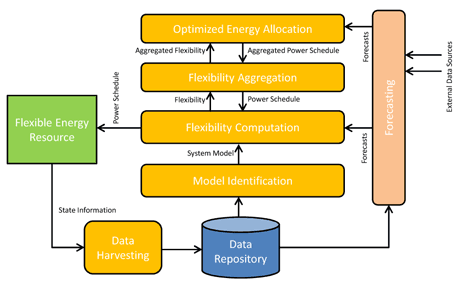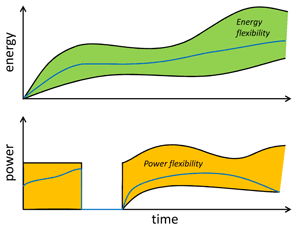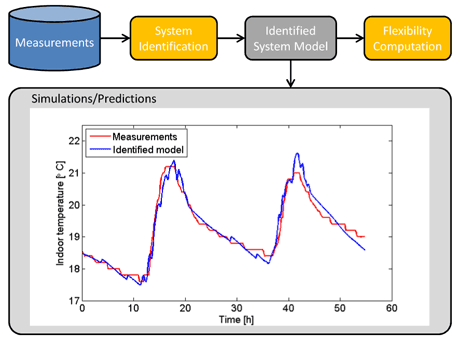by Olle Sundström, Fabian Müller, Carl Binding, Bernhard Jansen and Dieter Gantenbein
To increase the share of renewable energy in the electric power system, smarter solutions are needed in many areas. The way we consume electricity needs to change so that consumption is to a greater degree influenced by the availability of energy. In a system with high penetration of fluctuating production, such as wind and solar power, all kinds of flexible loads need to be identified and utilized to balance the supply and demand.
At IBM Research – Zurich, we are involved in various research projects that focus on enabling an increased penetration of renewable energy in the power system. Energy can be buffered directly by, for example, the thermal mass of a house or the energy storage in a battery. Energy can also be indirectly buffered by time-shifting the consumption, for example, by starting an appliance at a different point in time than intended.
A first area of investigation has been the use of a large fleet of electrical vehicles (EVs) in the context of the EDISON project, where energy buffering was to be provided by the EV batteries [1]. Currently, we focus on thermal storage, be it for industrial cooling and refrigeration purposes or for domestic heating applications in the context of the EcoGrid EU project [3].
Our general approach is structured as follows:
- Identify a mathematical model describing the underlying physical model. For that purpose, we use system identification techniques based on observed historical data.
- Using observed data, we derive forecasts of future use of these systems. For example, we formulate trip predictions for EVs or predictions on hot-water usage in the case of boilers.
- Based on the predictions and the system model, we compute the flexibility in terms of the electricity needed from the power system.
- This flexibility allows us to allocate power over time in such a way that the demand requirements are fulfilled while, for example, following stochastic renewable generation.
- The optimal power schedule is computed and communicated to the flexible energy resource as a control signal.
A schematic architecture of our approach is shown in Figure 1. We distinguish several layers. First, there is the data-collection layer, in which we use a large-scale communication and sensing infrastructure to harvest usage and generation information. A second functional layer performs the system identification.

Figure 1: System architecture
A third layer computes the flexibility of the energy systems. We indicate minimum and maximum usage boundaries and, based on these, derive a minimum and a maximum inflow of energy needed to satisfy demand. Figure 2 illustrates this flexibility. The energy and power taken from the power system over time are constrained to remain within the energy and power flexibilities. All trajectories within the flexibility bounds would satisfy user demand, but differ in the timing of replenishment.

Figure 2: Schematic flexibility, with minimum and maximum energy needs and minimum and maximum power flexibility, together with a realization of the flexibility (blue curves)
A fourth layer aggregates the flexibility, and the fifth optimizes the use of the flexibility. Here, optimization techniques are used to achieve the best usage of energy generation versus demand in general.
Our current focus is on applying the above energy-buffering paradigm and the system architecture in the framework of the EU project EcoGrid, where the main energy buffering is represented by home-heating systems driven by heat pumps. The system's flexibility is bound by the comfort zone set by the user, who may tolerate a temperature band around a set point.

Figure 3: Modelling a home-heating system
We have achieved initial results in system identification based on the data collected in the pilot setup. Figure 3 illustrates the quality of the system modeling using the indoor and the outdoor temperature as well as the influence of solar radiance.
References:
[1] O. Sundström and C. Binding: “Flexible charging optimization for electric vehicles considering distribution grid constraints”, IEEE Transactions on Smart Grid, Volume 3, Issue 1, pp. 26-37, 2012
[2] O. Sundström, C. Binding, D. Gantenbein, D. Berner, and W. Rumsch: “Aggregating the flexibility of domestic hot-water boilers to offer tertiary regulation power in Switzerland”, in proc. IEEE Intelligent Smart Grid Technology Conference, Berlin, 2012
[3] D. Gantenbein, C. Binding, B. Jansen, A. Mishra, and O. Sundström: “EcoGrid EU: An efficient ICT approach for a sustainable power system”, in proc. Second IFIP Conference on Sustainable Internet and ICT for Sustainability, Pisa, Italy, 2012.
Please contact:
Olle Sundström
IBM Research, Switzerland
Tel: +41 44 724 8871
E-mail:











